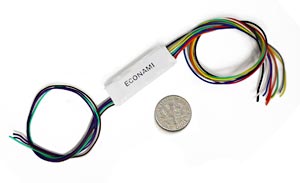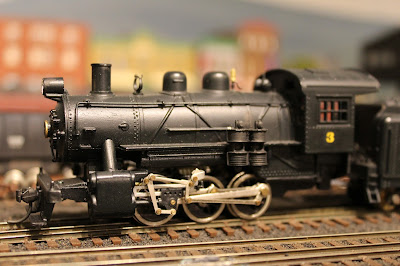Columbus Day weekend the Friends of the East Broad Top (FEBT) gathered for their annual fall Reunion in Rockhill Furnace, Pennsylvania. This was my first Reunion, and I was looking forward to spending a few days exploring the railroad and meeting some of the people who have worked hard to preserve this unique narrow gauge railroad. I made arrangements to stay at Pogue Station, an old farmhouse and general store that once served as a flag stop for miners on their way to the coal mines on Broad Top Mountain.
Pogue was the first stop after Orbisonia Station and only a few minutes from the main shop complex in Rockhill. Just north of Pogue Station, the EBT crossed Aughwick Creek on the longest bridge on the railroad. Pogue Trestle hasn't seen a train since the early 1960's, but the steel span was still impressive.
After a grueling 10 hour trip from Cape Cod to south central Pennsylvania, I finally arrived and registered at Reunion central in the local elementary school, just across the tracks from the EBT shops and the Railways to Yesterday trolley museum. Some eighty EBT supporters gathered for a presentation by Lee Rainey on the role of iron mining and smelting in the early history of the railroad. Rainey, author of the definitive book on the East Broad Top, explained how the railroad was originally founded to serve the Rockhill iron furnaces and coke ovens, the ruins of which can still be found in Blacklog Narrows, just east of the shops.
Saturday morning, I arrived early and spent an hour or so photographing the Rockhill yard in the bright but chilly morning light. The Friends of the East Broad Top, led by President Lee Rainey, have worked long and hard to preserve the hundred year old shops and roundhouse. Without the FEBT, many of the historic structures would have long since fallen down or collapsed.
One of the highlights of the weekend was a walking tour of the Rockhill restoration projects. We met near the Blacksmith Shop, which has recently been stabilized and painted. The building had been in danger of collapse prior to the restoration.
After an overview of recent restoration work, the group explored the interior of the foundry, where scrap iron was melted down and cast into parts for the railroad. The foundry is dominated by a huge 360 degree crane. While much work remains to be done on the interior, the exterior looks much as it did in 1956.
The group then walked to the south end of the engine shop, where Bill Adams showed the group some of the work continuing on restoration of the shop doors. The FEBT is building exact reproductions of the existing doors, which were in very bad shape.
Right next to the door project, FEBT members could see the work that has been done on the car shop. One of the iconic photos of the shops shows a stack of locomotive tires leaning against the wall of the car shop. Unfortunately, the weight of the tires had caused the entire wall of the building to lean as well! Volunteers working by hand moved the tires away from the walls so they could be braced and strengthened.
Another major project involved the roof of the car shop. Decades of rain, snow and neglect had rusted the corrugated panels and rotted the beams beneath, so that if a person stepped on the roof, he would go right through! Standing next to piles of debris, we looked up at a shiny new metal roof that will continue to protect the car shop for years to come.
The restoration tour ended at the paint shop, which is used by the FEBT for a variety of projects. Currently it houses 1890's combine number 14, which was used as a caboose on coal trains in the last years of EBT common carrier operation. The crews found the combine more comfortable than the two cabooses that are currently stored in the car shop. Skilled FEBT craftsmen have removed rotted wood from the sides, the roof and the interior, and are hand crafting replacements.
Work is proceeding well, but the car may never roll again. The wooden trucks that once supported the combine are in dire need of rebuilding, including replacement wheels. Unfortunately, the cost of replacing the trucks is prohibitive, and neither the railroad nor the FEBT has the funds. The FEBT will continue work on the car, but its future remains in doubt.
None of the six steam engines were operating for the weekend. In fact, the EBT has not had a locomotive under steam since 2012. The M-1 gas electric car is operational, but was not available for the Reunion. Instead, FEBT members were invited to ride one of three speeders (sometimes called "put puts") from the yard complex to the southern end of useable track, about a twenty minute round trip. The speeder rides were very popular. My first ride was the M-3, a 1920's era Nash vehicle that was restored by the FEBT several years ago.
Speeders left the vicinity of the roundhouse and proceeded south past the machine shop, locomotive shop and sand tower, to where a three way stub switch offered access to the main line. Passing the concrete coal dock and water column, the speeders passed two small sheds that were the first buildings restored by the FEBT. More recently, the organization has done restoration dock on the coal dock and water supply.
In addition to the M-3, two other small open speeders, once used by track crews, carried passengers back and forth throughout the day.

at
Saturday afternoon included an open house at the shops and roundhouse, with key members of the FEBT available for questions. I opted to visit the roundhouse first, where the EBT's stable of Baldwin 2-8-2 Mikados are stored next to the M-1 gas electric. The roundhouse has eight stalls. The group was free to explore around the locomotives, some of which have not moved since 1956. The engine most recently under steam is #15, which lacks only an FRA inspection to operate. Others that have operated in the tourist era include 12, 14 and 17.
FEBT President Lee Rainey was on hand to answer questions about the past, present and future of the railroad.
From the roundhouse, it was a short walk to the shops, where a small group wandered through the various work areas. The afternoon sun filtering through dusty windows illuminated machines and tools still sitting exactly where they were when the railroad closed in 1956.
Everything was as if the employees expected to return in a few days and work would pick up where they left off. But they never came back and today the shops are a perfectly preserved museum of the age of steam.
Huge lathes, drill presses and other machines were all drived by an elaborate network of belts and pulleys powered by twin boilers and a steam engine that has been restored to run on compressed air by the FEBT "boiler rats", as they like to call themselves.

Following the speeder rides and the tours, the group reassembled in the elementary school for a presentation by Peter and Jane Clarke on modeling the ganister rock and pig iron industries on their model railroad, featured in the latest issue of Great Model Railroads by Kalmbach Press. We then proceeded to the trolley museum next door for a ham and green bean dinner to cap off the day. Following dinner winners of the photo and modeling contest were announced. To my surprise (this was, after all, my very first reunion) I was awarded first prize for structures and a new category called "what if". I had submitted several vehicles suggesting what the short-lived EBT Transit Company might have looked like if the company had continued into the 1950's. There were many entries, many of them outstanding, so it was an honor to be included among those recognized for their modeling.

The evening wrapped up with a ride on a Metro Liner operated by Railways to Yesterday and a fund raiser auction back at the elementary school. That concluded the organized events. But the Reunion continued on Sunday with an open house at the FEBT museums in Robertsdale along with visits to various model railroads in the area. I had scratch built the well-known structures in Robertsdale's "company square", but this was the first opportunity to see the prototype builds as they are today: the Robertsdale station, the old post office and the Rockhill Iron and Coal Company office building. The fourth structure in company square -- the company store -- was torn down in the 1990's.



While touring the museum in the old post office building, I ran into two people who probably know more than anyone else about the coal mining operations on the Broad Top: Ron Pearson, who has published numerous articles in the FEBT journal, the Timber Transfer, and Ric Case, who together with Ron has explored the nine mines and surrounding area served by the East Broad Top Railroad.
Ron pointed out that from the Robertsdale station, one could see the remains of mine number 1. He and Ric invited several of us to join them in exploring the ruins. As we walked along the old EBT main line towards Woodvale (the end of the line) Ric pointed out the rotted posts that had supported the tipple for Mine Number 1.
Ron explained how the mines were operated by cables, powered by a steam winch, that pulled loaded coal cars from the mine while simultaneously lowering empties back into the mine to be filled again. Miners were expected to fill the dump cars with a minimum of 2100 pounds of coal; anything less than 2100 pounds and the miner would not be paid! Each miner was expected to fill 16 cars a day; hence the song by Tennessee Ernie Ford: Sixteen Tons.
As we tramped through the brush and brambles, Ron and Ric pointed out traces of the now long-gone mines -- the foundations of the steam winches, the boilers for the stationary engines, the fences for the mule barn (underground carts were hauled by mules).
At one point we found the remains of a fan house that circulated air in the mine still standing. The structure was the prototype for an identical fan house now available in HO scale!
Tramping through the woods and seeing the decaying remains of the railroad and mines, I began to realize more clearly how intertwined they were: the mines depended on the railroad, and the railroad would not exist were it not for the mines. When the demand for Broad Top coal dwindled, the EBT's days were numbered. Were it not for its surprising return as a tourist attraction, little would remain today. As it is, by extraordinary good luck and the help of the Kovalchik family (who bought the entire railroad in 1956) all of this history would be lost in the mists of time. We are so fortunate to have had the EBT for nearly 60 years after it ceased to operate as a common carrier. Hopefully, a way will be found to preserve the railroad and its history for generations yet to come.



















































